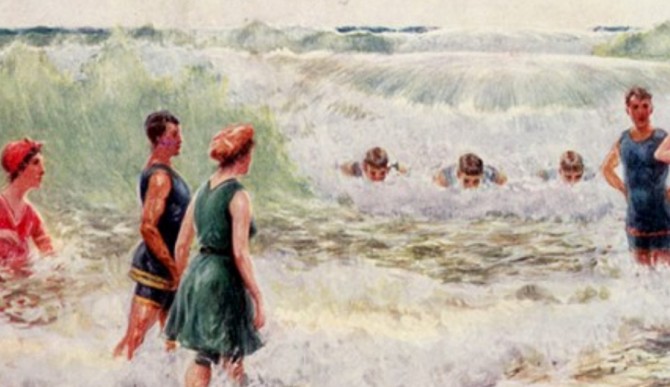
“Surf Bathing, Shooting the Breakers,” 1911, Percy Spence.Photo: Courtesy of Swell Lines Magazine
Prone:
1. Likely to or liable to suffer from, do, or experience something, typically something regrettable or unwelcome.
2. Lying flat, especially face downward.
The Prone Form of bodysurfing is characterized by the rider leading with the head while aligning both arms parallel to the torso. Riding Prone, the bodysurfer experiences the Ocean nose-to-surface. This raw style puts the human processing center in full exposure to the elements. While riders still drop the wings and prone it from time to time, the prone position is the root of modern-day bodysurfing.

Bodysurfers circa 1912. Photo: Courtesy of Swell Lines Magazine
If you were walking the beaches of Waikiki or in the 1900s, you would likely see Proning in action. The Prone position is the classical bodysurfing form. Riders would jump into waves before they had fins and ride straight as long as possible. To show style, a rider could hold up one foot and keep riding. It is unclear who was the first bodysurfer to break from Proning straight ahead to the beach. The break from prone form most likely developed concurrently with riding parallel to the shore with the breaking wave. There are many stories of people who began riding along the shore with one arm out the way surfers rode. Whether it was an early lifeguard on the California shores or native bodysurfing peoples of Polynesia or Hawaii it is clear our roots are in the belly-down, head-up position. As late as the 1960’s (footage below found on The Encyclopedia of Surfing), many bodysurfers around the world prefer the Prone position for wave gliding.
It could be argued that bodysurfing in the Prone position is a more intimate interaction. Bodysurfing on your belly leaves the rider eye to eye with the Ocean. The rider’s head is free from spray and the rest of the body is in full contact with the water as opposed to using a forward hand to plane. When riders use a forward hand to plane they naturally rotate their torso lifting one shoulder and some of the upper torso away from the water. This also causes a chain reaction pulling the head away from the surface of the Ocean. Many riders compensate for natural tendencies and force their face down the line, but in it’s most natural presentation Proning is the bodysurfer’s choice for feel.
The feeling may be multiplied by the vulnerability of the Prone Form. The most serious of injuries occur to a bodysurfer’s head, neck and back. There is no doubt that Proning, as the name implies, leaves the rider vulnerable to injury. Without a lead arm or arms, bodysurfers will make first impact on rock, reef and sand with their head. This is one of the many reasons the evolution of bodysurfing has moved beyond Proning.

Competitor Proning off the foamball. Photo: Courtesy of Swell Lines Magazine

Mark Cunningham taking Prone Form to the beach at the end of his heat at WBC 14. Photo: Courtesy of Swell Lines Magazine
When bodysurfers are in the layout position, leading with one arm, they are able to adjust to the changing steepness of the wave. This is mainly due to the great flexibility of the shoulder joint. If a wave suddenly turns from a mushy-spiller to a round barrel the rider can compensate with the lead hand to maintain planing surface. In the Prone position, bodysurfers are one-dimensional; therefore bodysurfers who ride Prone and ride it well are demonstrating expert ability. The Prone rider must be extremely observant of shifting wave movements, and then position him or herself with precision to ride out critical waves.
There are some riders who just like it. They may turn and Prone into the late barrel knowing there’s no hope of coming out the other side. His friends might even yell, “Canonball!” at the sight of such hopeless debauchery. Other bodysurfers look both ways and know the only way to feel this wave is to lock your arms to your side and launch straight for the sand. When the wave doesn’t give you left or right, you go straight simply because its fun.

The rider having the most fun… Photo: Courtesy of Swell Lines Magazine
There are variations of the Prone ride. In some old footage, you will see bodysurfers using one of their arms as a rudder to stall or change direction. When riding Prone, riders also vary the positioning of their head from down full speed ahead to chin fully extracted from the water and eyes at the sky. In all variations of this bodysurfing throwback, we share the thrilling sensations of wave pioneers long gone. We carry on the oldest wave riding tradition sliding on the surface with the purest joy.
This article originally appeared on Swell Lines: The Bodysurfing Magazine. See more of their work by visiting their website, SwellLinesMag.com.
Sources:
No Lives Lost: The History of Surf Life Saving Club 1908-1958 via Surf Research

